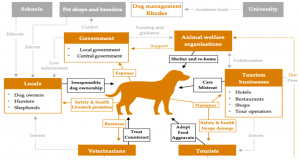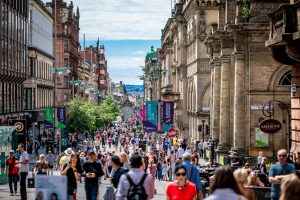Introduction
Tourism is one of the fastest growing industries worldwide and therefore plays an important role in the economy of most countries. This sector is often regarded as a driver of economic growth in many developing countries, which have limited growth options in other sectors (Scheyvens & Russell, 2009). However, mass tourism and rapid tourism development have often led to negative impact on the environment and culture of tourist destinations. Rapid development of tourism has resulted in environmental and social problems, such as noise, water pollution, biodiversity loss, draining of wetlands, destruction of coral reefs, impacts on the host community, etc. (Das & Chatterjee, 2015; Inskeep, 1991; Marschall, 2011). Hence, the question arises how tourism in developing countries should be developed to prevent or reduce negative impacts.
Ecotourism is an alternative tourism approach that has the goal of conserving the environment, while bringing economic benefits to inhabitants (Ceballos-Lascurain, 2012). Ecotourism has the potential to contribute, or already has contributed, to the socio-economic development of less developed countries, especially in Small Island Developing States (Das & Chatterjee, 2015; Gibson, 2010; Hollinshead, 2004; Mowforth & Munt, 2009). Ross (2012) mentions that in resource-based developing countries, ecotourism may also contribute to rural development by strengthening fragile local businesses. Ecotourism has, however, also been criticised due its occasional lack of success and sometimes only limited contribution to economic improvement. Hence, how can ecotourism be successful?
The thesis research which is the basis for this paper focused on the Solomon Islands, which belongs to the Small Island Developing States (Australian Government Department of Foreign Affairs and Trade, 2015). It is currently facing several challenges to develop and at the same time suffers from environmental degradation, due to the practices of logging, mining and overfishing (Central Intelligence Agency [CIA] Factbook, 2015; Secretariat of the Pacific Regional Environment Programme, 2014). As these are declining industries, alternative industries have to be found. Tourism in Solomon Islands is in its infancy, small in scale and – compared to other South Pacific countries – low in tourism arrival numbers (South Pacific Tourism Organization, 2015). Only relatively little research has been conducted about tourism in Solomon Islands.
The goal of the thesis research was: To identify if ecotourism is a suitable tourism development strategy for the Solomon Islands, and if so, what would be needed to make it successful.
Methods
The research design was of exploratory nature and consisted of various research methods: Secondary research was based on desk research, such as journal articles, books, newspaper articles, governmental publications, tourism strategic plans, NGO reports and statistics. Primary research consisted of semi-structured interviews, focus groups and unstructured participant and non-participant observation. Interviews were conducted with representatives of the public and private sectors, accommodation providers, local communities and tourists. Especially in the primary research, a pragmatic approach had to be employed, as theory and practice are often very different (Bailey, 2007), and the exploratory nature of the research meant that flexibility was required throughout the whole research process (Brown, 2006).
Findings and discussion
Solomon Islands is not a mass tourism destination and should not become one. It is suggested by this research that ecotourism does, indeed, represent a suitable tourism development strategy for the country, even though it is not a one-size-fits-all approach. That is, it may not be a suitable development approach for all communities, especially those which are very difficult to access. The research resulted in a list of key factors needed to make ecotourism successful on Solomon Islands.
Ecotourism is only one of many definitions of alternative tourism. Alternative are sustainable tourism, ecotourism and nature tourism. Dolnicar, Crouch, and Long (2008, p. 105) argue that “without agreement on the definition of ecotourism and the Eco tourist we will continue to produce knowledge that, rather than being pieces of a puzzle, are pieces of different puzzles, thus preventing the full ecotourism picture to be visible’. In the end, however, what really matters is that the definitions and ideas of those types of tourism are put into practice and do not just remain concepts. The need for ‘A clear definition of ecotourism’ is therefore translated into the need for national standards and the establishment of criteria for eco-labelling and certification (Amacher, Koskella, & Ollikainen, 2004; Das & Chatterjee, 2015; Haaland & Aas, 2010; Rio & Nues, 2012; Tepelus & Cordoba, 2005). Tourism businesses that meet the eco standards would receive the eco-labelling and certification. This would ensure that they follow and abide by eco standards. At the same time, the operators would also benefit, as they can use it as a marketing tool.
One criticism of ecotourism is that often the more powerful people within a community are the ones that benefit from tourism development (Farrelly, 2011; Litka, 2013). McCool (2015, p 280) states that “the homogeneity of small villages implicit in many development initiatives are often exposed to rancour, jealousies and conflict introduced by the perceived inequities in resulting incomes and opportunities”. In this research it was found that jealousy existed in communities, especially if they saw that one person got more benefits than others. Hence, it is important that the community can see the benefits and that the tourism operators try to involve the community in hosting tourists. Ecotourism can provide economic incentives for the community and improve living standards, such as sanitation, water tanks, plumbing, health services, school education, etc. It is conceivable that a village entry fee, visitor’s tax and/or a community fund could ensure that. Furthermore, the key to success of ecotourism is to involve the local community in the entire process from ecotourism planning to execution and monitoring (Rowat & Engelhardt, 2007; Stone et al., 2008).
Another criticism of ecotourism is that it is a “social trap” for communities as it might lead to promises in the short term, but might cause disadvantages in the long term (McCool, 2015, p. 276; Costanza, 1987; Platt, 1973). Hence, high promises about ecotourism should not be made. Awareness should be created that, for instance, tourism might only develop slowly and that benefits can only be seen in the long term. In addition, communities should be encouraged to continue with their usual occupation. Ecotourism should be seen as an additional income source to cover expenses such as school fees, books or improving public facilities such as sanitation, church buildings, schools, etc.
For the successful development of ecotourism, it is crucial that tourism stakeholder see the potential and benefits. The thesis research has namely shown that tourism stakeholders have a large influence on shaping tourism development. They are responsible for the tourism product and the image of a destination.
Market research is also an important prerequisite for the successful development of ecotourism. There are more people travelling than ever (UNWTO, 2015) but travellers from some emerging markets, such as China and India, are demanding quantity and cheap travelling. However, travellers from other countries are willing to spend more money on eco-friendly practises and are also looking for new destinations (Blangy & Mehta, 2006; Das, 2011; Dolnicar, Yanamandram & Juvan, 2013). Market research is crucial in order to find out what different types of travellers are looking for and if there is potential for a new niche market. More people are e.g. willing to spend money on environmental friendly products, organic food, etc. (Blangy & Mehta, 2006; Das, 2011; Dolnicar et al., 2013).
Barriers for the implementation of ecotourism might be to convince all tourism stakeholders to agree to sustainable practices. In the beginning it might be more cost intensive and time consuming, as investment in sustainable practices, such as waste separation, alternative energy sources, awareness and training of employees and partners will be necessary. However, in the long run returns will come, as it can be one way to differentiate Solomon Islands from other destinations.
Tourism on Solomon Islands until now rarely had any negative impacts on the environment and the local community. However, to ensure this in the future conservation of the environment, involvement of the community and all stakeholders has to be a priority. The country needs to understand why tourism is growing and that everyone should try to work in one direction. Solomon Islands needs to accentuate its differences with other South Pacific islands, and focus on its niche markets, such as ecotourism. Solomon Islands is just one example of a Small Island Developing State or developing country that has potential for ecotourism.
In developing ecotourism destinations should be aware that ecotourism can be regarded as a micro solution to a macro problem (Wheeller, 1991). Even if it is not possible to achieve the goals of ecotourism fully or to solve the underlying problems, the aim should be to aim for improvement. The vital question is what can be done for more local communities to share the benefits of tourism – increasing their basic living standards and at the same time conserving the environment. Ecotourism has big potential for sustainable success in Solomon Islands and other countries, provided governments and stakeholders recognize and share this vision, and commit themselves to their role in its development.






